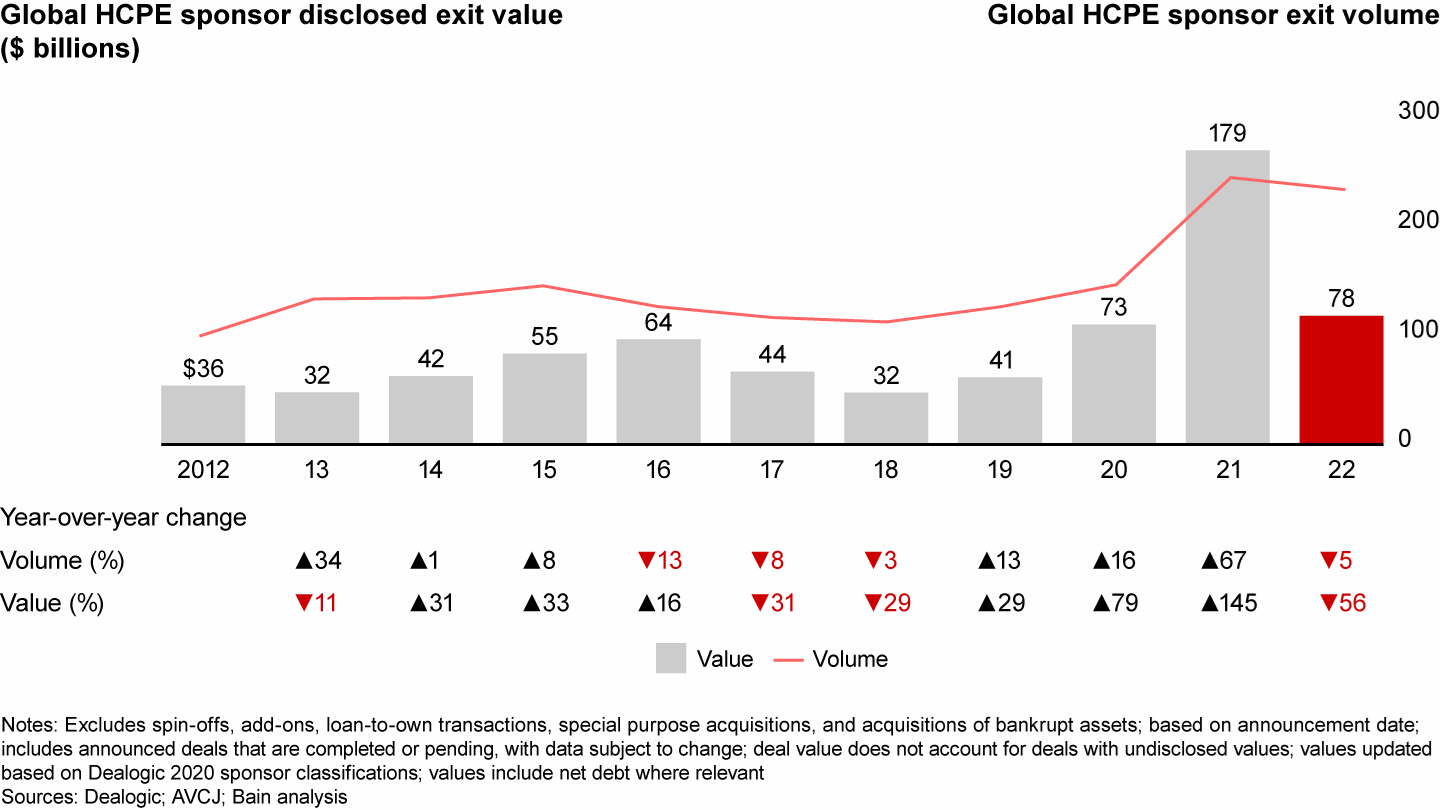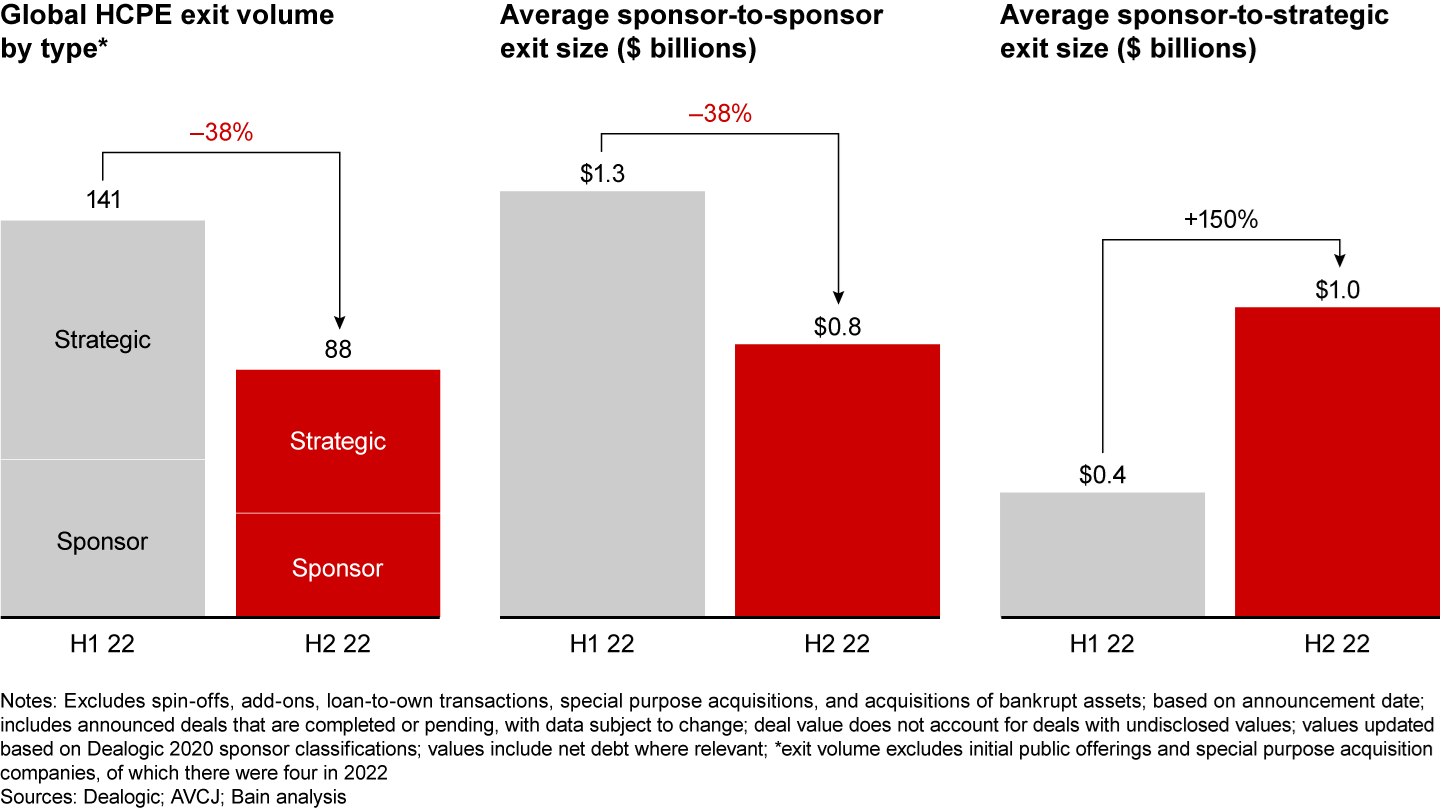Global Healthcare Private Equity Report

At a Glance
- Strong exit activity in the first half of 2022 overcame the sharp drop-off in the second half. Despite declines in exit volume and value, global healthcare private equity exits are on track for their second-best year.
- Macroeconomic conditions affected exit types differently, with sponsor-to-public exits nearly vanishing and sponsor-to-strategic exits shining. Sponsor-to-sponsor exits shrank in size in response to financing challenges.
- While it remains to be seen how 2023 will play out, a sustained downturn may shift the mix of exit strategies, decrease average exit size, and lengthen holding periods.
- That said, grounds for optimism range from record exit volume in certain pockets, to a wealth of sponsor-owned assets yet to retransact. About 45 healthcare assets purchased by sponsors four to five years ago for at least $500 million have yet to retransact.
This article is part of Bain's 2023 Global Healthcare Private Equity and M&A Report.
A tight credit market and depressed public and private market valuations led to a decline from 2021’s record exit activity. Despite this, 2022 saw higher exit volume and value than any year besides 2021, making it the second-best year by both measures (see Figure 1).
Despite falling, exit value in 2022 was the second best on record, while exit volume held steady


Total exit volume for 2022 was 233, down slightly from 244 in 2021. Deal value declined more sharply, from $179.3 billion to $78.4 billion. A few large exits inflated total deal value in 2021, with the top five exits worth $72 billion alone. Excluding those departures, exit value declined about 27% in 2022 from the previous year.
Macroeconomic conditions affected exit types
More than overall exit value and volume, the macro environment in 2022 had a pronounced impact on the mix of exit types.
Sponsor-to-public exits: We predicted in our report last year that exiting via public markets would become less attractive in 2022. This prediction played out as depressed public markets and proposed special purpose acquisition company (SPAC) regulations from the US Securities and Exchange Commission made sponsor-to-public exits all but vanish from the exit landscape. More specifically, we saw only four public exits in 2022 and none greater than $1 billion in disclosed value—a stark decline from the combined $37 billion in public exits of this size in 2021.
Sponsor-to-sponsor exits: Sponsor-to-sponsor exit volume hit a record in 2022 with a total of 93 exits, up 22% from the previous year. However, as the credit market tightened, large sponsor-to-sponsor exits slowed as the year progressed. The majority of sponsor-to-sponsor exits with a disclosed exit value greater than or equal to $1 billion occurred in the first half of 2022. As such, average sponsor-to-sponsor exit size shrank from $1.3 billion in the first half of the year to around $810 million in the second, a 38% decline (see Figure 2).
The Asia-Pacific region was a notable exception here, as sponsor-to-sponsor exits were an important driver of its resilience in the second half of 2022. Just under 80% of Asia-Pacific’s total exit value for the year came from sponsor-to-sponsor exits in the second half.
Sponsor-to-strategic exits: With cash on hand, strategic buyers became an important driver of exit volume and value as 2022 progressed. In the first half of 2022, strategic exits accounted for 29% of disclosed exit value. This sharply increased to 68% in the second half. It was also a record year for sponsor-to-strategic exit volume, up about 9% from 2021 for a total of 136 exits.
Strategic exits were more viable for large assets in the second half of 2022


A sustained downturn could change the exit landscape
While it remains to be seen how 2023 will play out, exit size, exit type, and holding period could all be affected if financing remains tight and public equity markets remain depressed.
Exit size: As mentioned, average sponsor-to-sponsor exit size declined 38% from the first half of 2022 to the second as large-check financing became increasingly difficult to secure. European and North American sponsor-to-sponsor exits felt this more acutely, declining in average size by 45% and 52%, respectively, between the first and second halves of the year. On the other hand, average strategic exit value increased by 150% between the first and second halves of 2022 as corporate buyers seized the chance to acquire assets with less competition from private equity. Aligned with the decline in average sponsor-to-sponsor exit size, this increase was felt particularly in Europe and North America.
Exit type: IPOs will remain less attractive in the face of depressed public equity markets, and strategic exits are likely to keep driving exit volume, especially if corporate buyers continue to have excess cash on hand. Partial recapitalizations and continuation funds could become more popular in a prolonged downturn as a means of providing returns to limited partners while also holding on to assets with more upside potential.
Holding periods: In the years following past downturns, we have seen holding periods extend as sponsors wait for favorable market conditions. While it is too early to tell how much of an impact the current macro uncertainty will have on holding periods, continuation funds and partial exits triggered by a prolonged downturn could contribute to longer holding periods.
Reasons for optimism vary across geographies
Despite these challenges, we see reasons for optimism across markets:
North America: Nearly 25 assets that transacted four to five years ago for at least $500 million have yet to retransact. More than half of these assets are provider businesses or provider-related services businesses. Additionally, 15 of these assets traded at valuations of at least $1 billion when they last transacted.
Europe: Europe had a record year when measured by total exit volume, with mega-exits—those in excess of $1 billion—continuing to drive exit value as they did in previous years. The share of European exits greater than $1 billion in disclosed value decreased from the first half of the year to the second half, both in terms of exit volume and value. However, in all, 2022 saw more $1 billion-plus exits in Europe than any other year aside from 2021. Looking ahead, roughly 10 European healthcare assets that were acquired four to five years ago for at least $500 million have yet to retransact.
Asia-Pacific: We saw more $1 billion-plus exits in the Asia-Pacific region than in any other year. The region produced the four largest sponsor-to-sponsor exits in the second half of 2022, totaling over $6.6 billion in value despite challenges in the macro environment. The region is on track for a record year when measured by total exit value, likely surpassing 2020’s $7.6 billion total value, provided that deals announced in December transact. Looking ahead, at least 10 Asia-Pacific healthcare assets that were acquired four to five years ago for at least $500 million have yet to retransact.